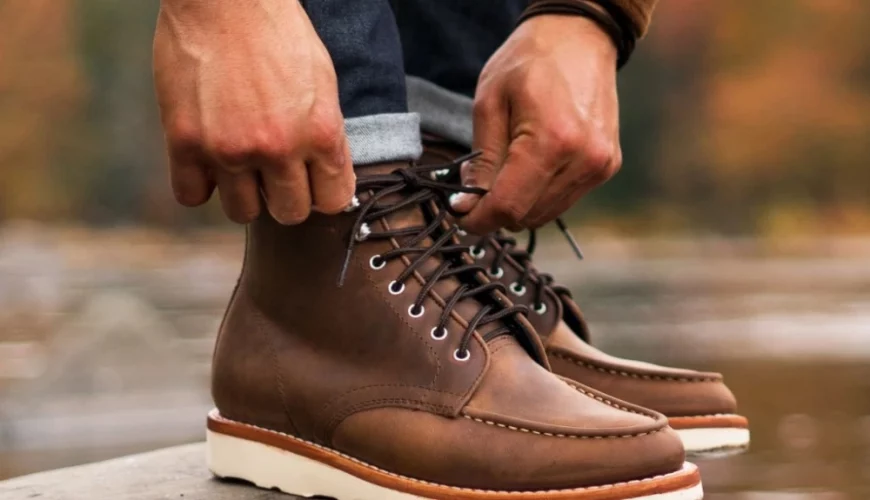Do you need new waterproof boots but don’t know which features to look for? Don’t worry, as we’ve got you covered. True waterproof boots will keep the water out while allowing moisture to escape.
Several unique materials make this possible, such as Gore-Tex and leather. However, waterproof boots don’t include only waterproof features. Durability, comfort, breathability, and even insulation are frequent elements of high-quality, waterproof boots.
Now, let’s dive into the details!
Components of Waterproof Boots
Before we get to features, let’s see how waterproofing works. Water can’t get in the boot, but it’s breathable enough to let the moisture out. What’s the trick? Let’s take Thorogood waterproof boots as an example. They often have two components – the waterproof membrane and the outer layer.
However, other high-quality brands also make their waterproof boots this way, as that’s a proven way of keeping your feet dry in wet conditions.
The Membrane
The waterproof membrane is the technological feature that keeps your feet dry in wet conditions. It keeps moisture out through an innovative breathing method.
The holes in the membrane are too small to let water in but large enough to let the moisture vapor get out. That means your feet can both stay dry and breathe. Typically, they go through an oil treatment to prevent losing waterproofness over time.
The Outer Layer
The outer layer is like the face of the boot. It can be made from waterproof materials like rubber, water-resistant materials such as leather, or water-permeable materials. It’s often treated with a durable water repellent (DWR), so it doesn’t soak up moisture.

Features of Waterproof Boots: Materials
Outdoor work and hiking often involve rain, snow, mud, rivers, and other wet elements. Mother Nature has its way of preventing us from doing our best at work or slowing us down. However, several waterproof materials will allow you to perform your best even in the wettest of conditions. Read on to learn more.
Waterproof Membrane
A waterproof, breathable membrane like eVent or Gore-Tex is bonded to a lining and inserted into the boot. The lining surrounds the foot and prevents water from coming through.
However, just because moisture can’t seep in, it doesn’t mean it can’t damage the outer layer of the boot. That’s why you should regularly treat your boots with water repellent for maximum durability.
Liners typically come in two forms – Gore-Tex/eVent or polyurethane (PU). Gore-Tex and eVent liners are brand-name icons that keep water out but let moisture vapor escape, letting your feet breathe. These are more expensive. PU liners do a great job at keeping moisture out but aren’t breathable, potentially causing discomfort during long hours spent on your feet.
Gore-Tex
Gore-Tex is a famous waterproof membrane, and for a good reason – it offers the best combination of breathability, protection, and comfort. It’s a proprietary brand of a waterproof membrane. The membrane is equipped with billions of microscopic pores, providing maximum breathability and protection.
Gore-Tex is the first waterproof, windproof, breathable fabric introduced to the public in the 1970s. It’s guaranteed to keep your feet dry. When you see Gore-Tex fabric in a boot, you can rest assured the boot has been tested under the toughest of conditions.
Leather
Leather is a material with natural water-resistant properties. Work and hiking boots are often made of treated full-grain or nubuck leather to increase their durability and resistance to water. While they are designed to be waterproof, you should avoid submerging them into the water since leather boots are made with seams that can let water seep in.
Synthetic Leather
Since leather deteriorates over time when exposed to water and requires constant care, some people prefer boots made of synthetic leather. It requires minimum care and provides high levels of durability. Therefore, you can use boots made of this material for various activities, including work, hiking, and sports.
Rubber
Rubber is a waterproof material typically used for making soles. It does an excellent job at protecting feet and offering flexibility. In addition, rubber provides outstanding grip both outdoors and indoors.
However, sometimes the whole boot is made of rubber. For example, fishers often wear tall rubber Wellingtons because they are completely waterproof, allowing them to walk through water.
Neoprene
Neoprene is another waterproof material commonly used in footwear manufacturing. Introduced in the 1930s, this synthetic material is a man-made alternative to rubber, best suited for mild physical activities.

Other Features Waterproof Boots Often Have
Besides waterproof features, these boots usually boast other properties as well. These include durability, breathability, insulation, and comfort.
Durability
True waterproof boots are typically made of high-quality materials, such as full-grain leather, offering high levels of durability. Durability is a vital feature every boot should have. However, some waterproof boots from questionable brands tend to fall apart after only a few months of regular use.
That’s why it’s critical to buy your boots only from reputable brands that use only quality materials. Otherwise, you’ll end up throwing them out, spending more money in the long run, and damaging our environment.
Look for durable waterproof materials like full-grain leather, rubber, or neoprene, as well as a Gore-Tex membrane. These will ensure you can wear your boots for years to come. There are several brands famous for delivering highly durable boots. These include Timberland PRO, Carhartt, Thorogood, and CAT, to name a few.
Breathability
The best waterproof boots will also offer high levels of breathability. Again, materials like Gore-Tex and leather are known for their breathability features. So, if you want your feet to breathe, ensure you get the boots made of breathable materials.
Otherwise, you risk developing unpleasant skin conditions, such as foot fungus. If your boots don’t allow your feet to breathe, it can also lead to excess heat and sweat in the area, preventing you from performing well on your job or enjoying otherwise fun physical activities.
Insulation
Many waterproof boots are also insulated. That’s because waterproof boots are often worn during fall and winter when temperatures drop and rain and snowfall more frequently. There are different insulation thicknesses to suit different levels of cold, starting from 200g going up.
Note that the thicker the insulation, the lower the mobility, and vice versa. So, before buying your waterproof, insulated boots, make sure you choose the insulation appropriate for your climate.
Comfort
The best waterproof boots don’t lack comfort features. Look for cushioned footbeds, shock absorption, and ergonomic design to ensure you get the most comfortable boots that will make your feet happy.
Apart from helping your feet feel good, comfortable boots will also boost your productivity and protect you from the pain associated with long hours spent walking or standing.
Enjoy the Rain with the Best Waterproof Boots
After reading this article, you have a good idea of what features waterproof boots have. This information can help you choose the best waterproof boots that will let you enjoy rainy days.
Waterproof or not, your boots should provide high levels of durability, comfort, and breathability. That’s why you should buy your boots only from reputable brands that use high-quality materials. Otherwise, you won’t have a good time in them, rain or shine.




